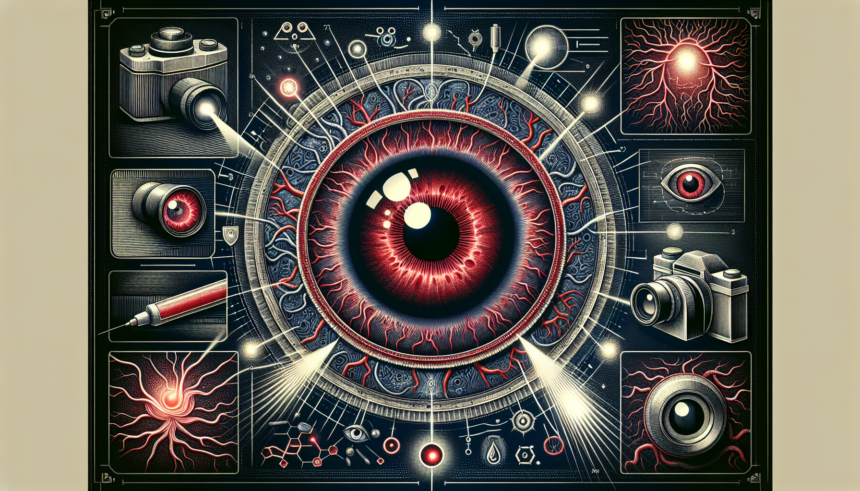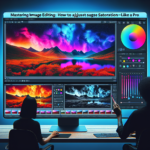Red-eye is a commonly observed phenomenon that occurs in photographs, particularly when using a camera flash in low-light conditions. This issue not only disrupts the aesthetic elements of photographs but also triggers curiosity about its underlying causes. Understanding the science behind red-eye helps photographers and enthusiasts mitigate its occurrence. This article delves into the principles behind red-eye, factors influencing its development, and potential solutions for producing flawless photos.
Understanding Red-Eye
Red-eye occurs due to a complex interplay between light and the structures of the human eye. When a camera flash is used in dim lighting, the pupils are generally dilated. A sudden burst of bright light penetrates the eye and illuminates the retina, which is richly supplied with blood vessels. The light reflects back through the pupil, and the camera captures this reflection, appearing as red in the photograph. This red coloration is due to the presence of hemoglobin in the blood vessels of the retina.
Causes of Red-Eye
Several factors contribute to the occurrence of red-eye in photographs. These include:
- Proximity to the Camera Flash: When the camera flash is positioned close to the lens, the likelihood of light entering the eye and reflecting directly back increases.
- Pupil Dilation: In low-light environments, pupils dilate to allow more light to enter the eye. A sudden burst of bright light from the flash does not give the pupils time to constrict, leading to a higher probability of red-eye.
- Angle of Illumination: The angle at which light enters the eye and reflects back can determine the extent of red-eye. Straight-on flash results in a more significant occurrence compared to off-camera flash or natural lighting.
- Anatomical Factors: Individuals with lighter eye colors or larger pupils may be more prone to red-eye due to the higher visibility of red retinal reflections.
Science Behind Eye Anatomy and Red-Eye
To fully grasp the science of red-eye, it is crucial to understand the anatomy of the eye. The eye comprises several parts: the cornea, lens, iris, retina, and optic nerve. The retina, which is responsible for capturing light and sending signals to the brain, is fundamental to the red-eye effect. The thin inner lining at the back of the eye is densely populated with blood vessels and specialized cells known as cones and rods.
When light, either natural or artificial, enters the eye, it is focused by the lens onto the retina. In low-light situations, the iris (the colored part of the eye) cannot restrict the pupil size quickly enough to the flash, resulting in light reflecting off the vascular retina, causing a red appearance in photos.
Solutions to Red-Eye
Thankfully, several techniques can reduce or prevent red-eye in photographs:
Pre-Shoot Techniques
- Increase Ambient Lighting: Increase the light in the room or area where photographs are being taken. Bright environments cause pupils to constrict, reducing the amount of light that can enter and reflect back as red-eye.
- Use Off-Camera Flash: By directing the flash away from the camera lens, the light does not enter the eye directly, minimizing red-eye reflections. External flashes or bouncing light off a surface are effective methods.
- Move Subjects Away from Backgrounds: Placing the subject farther from walls or surfaces can help in reducing direct flash reflections into the camera.
- Red-Eye Reduction Mode: Many cameras come equipped with a red-eye reduction setting. This mode sends a pre-flash to constrict pupils before taking the actual photo with the main flash.
Post-Shoot Corrections
- Photo Editing Software: Various editing tools and software, such as Adobe Photoshop or smartphone photo apps, offer red-eye correction features. These tools allow you to manually or automatically reduce the redness in the eyes.
- Retouching Apps: There are several mobile applications specifically designed for red-eye correction. These apps are user-friendly and can quickly amend photos on-the-go.
The Role of Technology
With advancements in technology, modern cameras and smartphones come with features designed to decrease the likelihood of red-eye. From complex algorithms to hardware improvements, understanding and utilizing these options can help in virtually eliminating red-eye.
- Red-Eye Reduction Mode: As previously stated, this mode uses a pre-flash to constrict the subject’s pupils, thus reducing the chance of red-eye.
- Multiple/Continuous Flash Systems: Some cameras utilize multiple flashes in quick succession, allowing the eye to adjust and minimize red-eye.
- Improved Flash Placement: Modern cameras often have better flash placement, reducing the proximity between the flash and the lens, thereby mitigating red-eye.
- Advanced Algorithms: Software in modern cameras uses advanced algorithms to detect and reduce red-eye effect post-capture, even before you transfer the pictures for further editing.
Professional Tips
Professional photographers use several additional techniques to avoid red-eye:
- Catchlights: Creating small light reflections in the eyes (catchlights) can make the subject’s eyes look more natural and lively. This is typically done using off-camera flash or reflectors that are placed off to the side.
- Proper Posing: Guide your subjects to avoid looking directly into the camera. Instead, ask them to look slightly up or to the side. This can help in reducing direct light reflections.
- Diffusers and Softboxes: Using diffused light reduces the intensity and harshness of direct flash, lowering the chances of red-eye.
Conclusion
Understanding the science behind red-eye not only equips photographers with the knowledge to counteract this common issue but also enhances the quality of their work. From manipulating ambient light to employing advanced technological features, various practical solutions and preventive measures can be implemented to minimize red-eye occurrence. Although this effect can be fixed in post-processing, taking proactive steps during the photography session saves time and maintains photo authenticity. Therefore, by integrating these strategies, photographers can consistently produce clear, eye-pleasing images that capture the viewer’s attention without distractions.
Frequently Asked Questions (FAQs)
1. What exactly causes red-eye in photographs?
Red-eye is caused by the reflection of light off the blood-rich retina at the back of the eye when a flash is used in low-light conditions. The pupils are usually dilated in these situations, allowing the flash to enter the eye and reflect back, appearing red due to the hemoglobin in the blood.
2. How can I prevent red-eye without using technology?
You can avoid red-eye by increasing ambient lighting, using off-camera flash, moving subjects away from backgrounds, and guiding subjects not to look directly at the camera. These techniques help to reduce the reflection of light off the retina.
3. Do all cameras have a red-eye reduction feature?
Many modern cameras, including most DSLRs and smartphones, are equipped with a red-eye reduction mode. This mode typically uses a pre-flash to make the pupils constrict before taking the photograph with the main flash.
4. Can red-eye be fixed after the photo is taken?
Yes, red-eye can be corrected in post-processing using various photo editing software and apps. Tools like Adobe Photoshop and mobile photo editing applications have specific red-eye correction features.
5. Are some people more prone to red-eye than others?
Yes, individuals with lighter eye colors, larger pupils, or those who are more likely to have dilated pupils in low-light conditions may be more prone to red-eye. Anatomical and physiological factors can affect red-eye prevalence.









